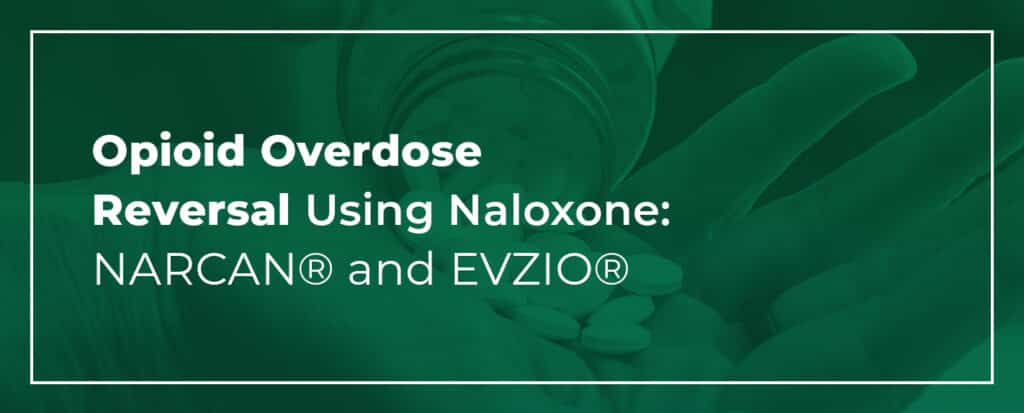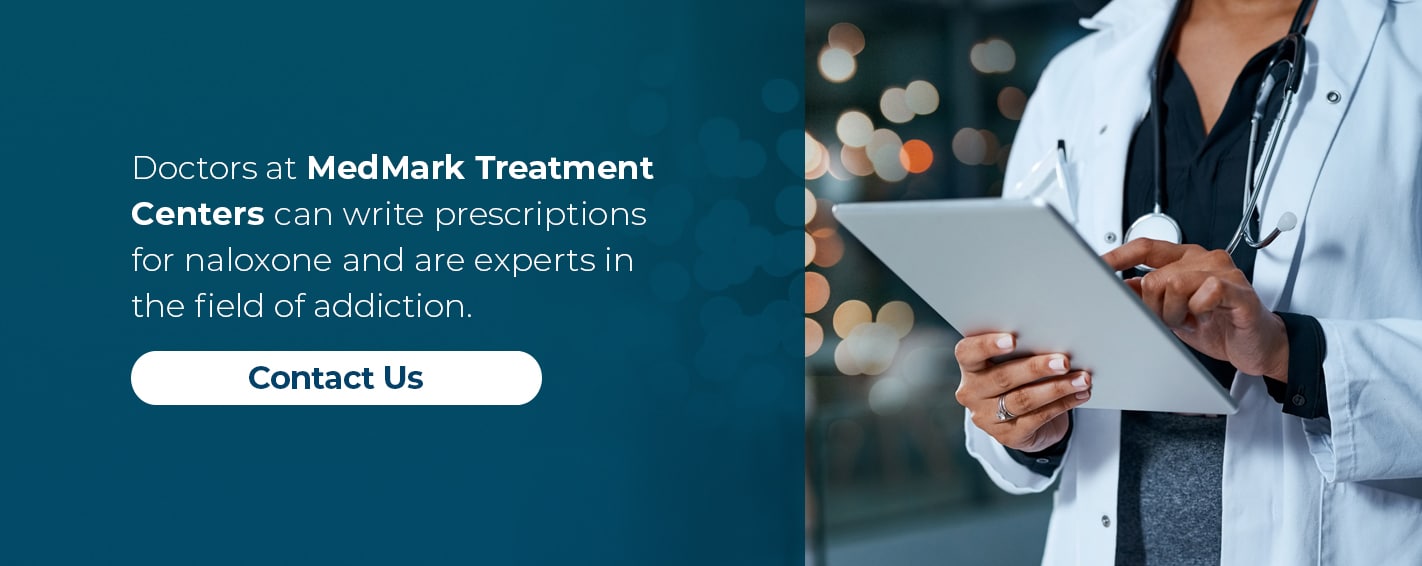If someone you know is taking prescription painkillers or abusing another opioid like heroin or morphine, one of the most frightening concepts to consider is the possibility of an overdose. Opioid overdoses happen with alarming frequency all across the U.S., and numbers have been rising steadily over the past two decades.
From 1999 to 2017, nearly 400,000 people died from an overdose that involved an opioid — whether illicit or illegally prescribed. Today, an average of 130 Americans fatally overdose on opioids. These figures are enough to cause anxiety in anyone. However, there is one significant way you can help put a dent in these sobering statistics: by learning how to use the medication naloxone.
What Is Naloxone?
Naloxone can reverse opioid overdoses quickly and safely in emergencies. Naloxone came about in the early 1960s, and the U.S. Food and Drug Administration approved it for treating opioid overdoses in 1971.
The development of naloxone went on hold for several decades until the toll of the national opioid crisis uncovered an urgent need for the average, medically untrained individual to provide the lifesaving medication. In 2015, the FDA approved a nasal spray almost anyone can use to reverse the effects of an opioid overdose.
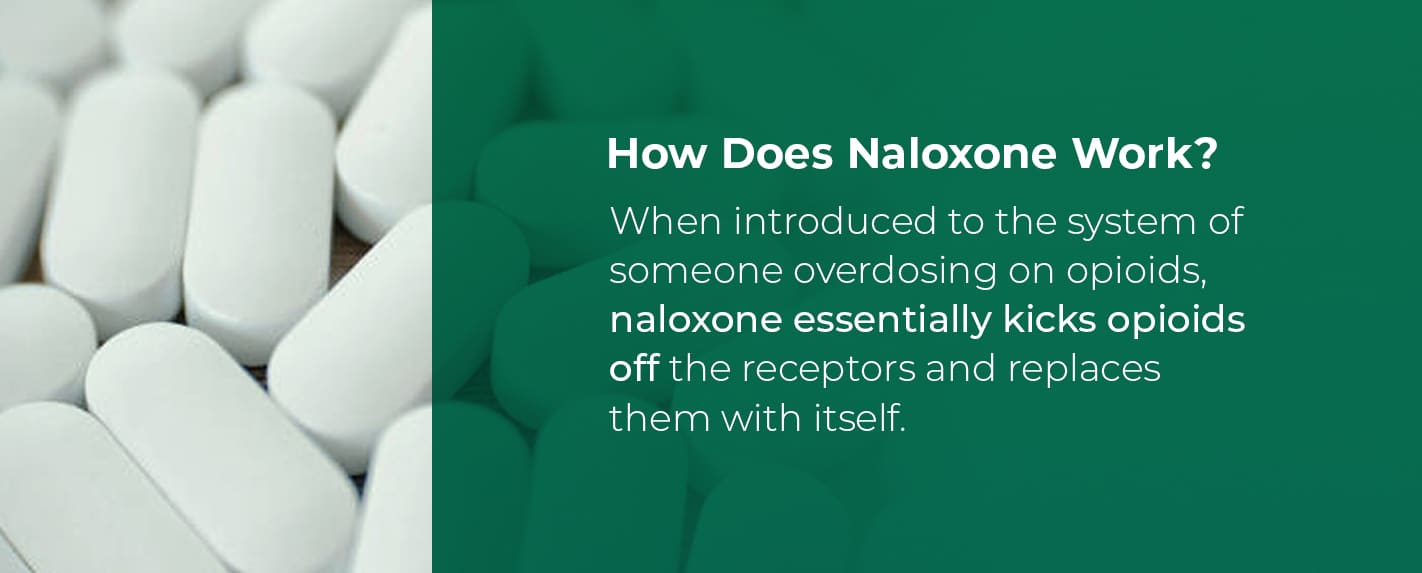
How Does Naloxone Work?
Naloxone works to reverse overdoses because it’s what we call an “opioid antagonist.” Drugs like heroin, morphine and prescription painkillers are agonists, meaning they bind to the brain’s opioid receptors and excite them, producing the effects opioid drugs are known to have. As an opioid antagonist, naloxone uses are twofold: It binds to the opioid receptors, but it does not trigger the effects of agonists like pain relief and euphoria. An individual without opioids in their system will experience zero euphoric effects from naloxone.
Naloxone has one of the highest affinities for multiple opioid receptors in the central nervous system. When introduced to the system of someone overdosing on opioids, naloxone essentially kicks opioids off the receptors and replaces them. When naloxone has bound to a receptor, it blocks opioids with less affinity. The naloxone dose formulated in FDA-approved medications displaces enough opioids from the body’s receptors to reverse the overdose effects.
One of the most advantageous properties of naloxone is that it doesn’t have any effect at all in people who are not on opioids, meaning there’s no potential for abuse. That’s why almost anyone can use it. Naloxone is also an abuse deterrent in some formulations of buprenorphine, an addiction treatment medication. The naloxone produces immediate withdrawal effects if someone tries to abuse the medication via injection, making it unpleasant, if not impossible, to misuse the prescription.
Brand Names of Naloxone to Ask a Doctor About
If you’re considering getting a prescription for naloxone, you’ll likely need to choose from one of the two well-known brand names currently available: NARCAN® and EVZIO. They both contain naloxone as their active ingredient, and they can both save the life of someone who is overdosing. They are also both suitable for use by individuals with no medical training, thanks to their simple application instructions. Both medications come in packages containing two doses, in case repeat dosing is necessary. The primary difference is in their application method.
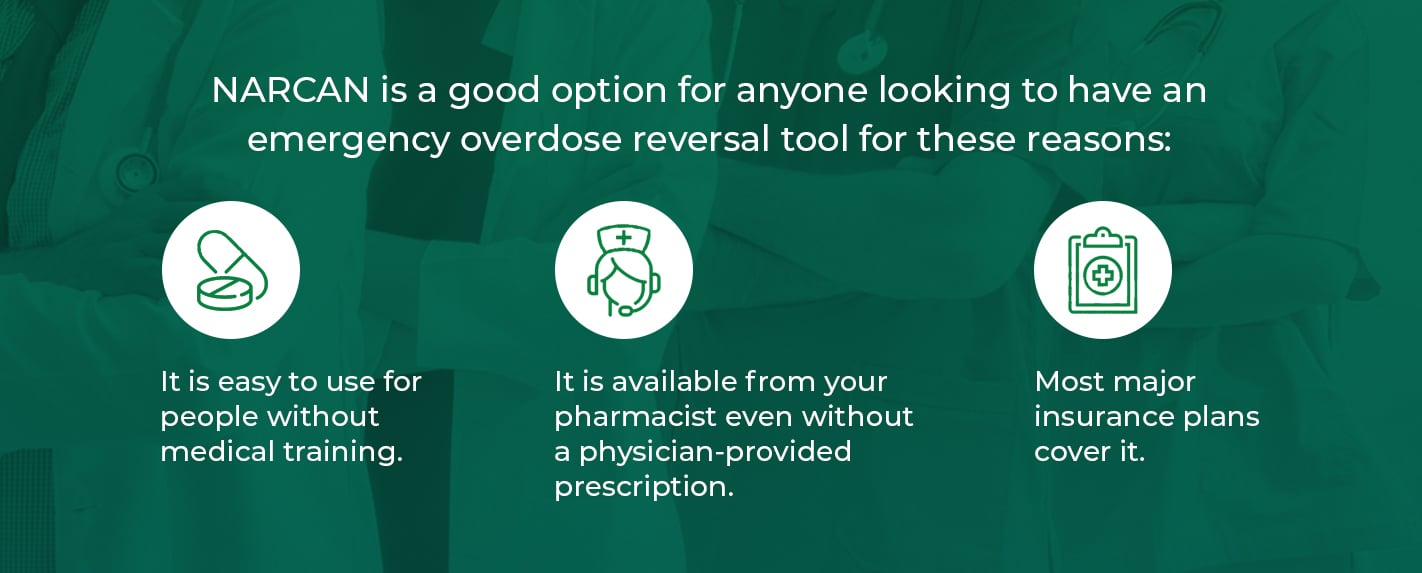
What Is NARCAN?
NARCAN is the first and only FDA-approved naloxone nasal spray. NARCAN is a good option for anyone looking to have an emergency overdose reversal tool for these reasons:
- It is easy to use for people without medical training.
- It is available from your pharmacist even without a physician-provided prescription.
- Most major insurance plans cover it.
It’s hard to imagine a more straightforward administration method than a nasal spray. With quick action, you can follow the three-step instructions for NARCAN within seconds, allowing you to restore breathing to an overdosing individual.
- Peel: Peel back the packaging to reveal and remove the device. Hold the device by keeping your thumb on the plunger bottom and two of your fingers on the device’s nozzle.
- Place: Place the tip of the nozzle in either one of the person’s nostrils until your fingers make contact with the bottom of the person’s nose, and hold it there.
- Press: Firmly press the plunger, releasing the dose into the person’s nose.
NARCAN is readily available to anyone who wishes to purchase it. Anyone can stop by the nearest major pharmacy and pick up a NARCAN kit without having to present a prescription. The cost of NARCAN varies slightly, but most pharmacies sell it for around $150.
If you choose to go through insurance, you will almost certainly pay far less. According to the naloxone manufacturer, nearly all public and private insurance covers NARCAN. About 97% of insured people have access to NARCAN at little to no cost. For example:
- 38% of prescriptions for NARCAN have a co-pay of $0
- 76% have a co-pay of $10 or less
- 80% have a co-pay of $20 or less
The ease of application and affordability of NARCAN make it a good option for anyone concerned about a loved one overdosing on opioids.
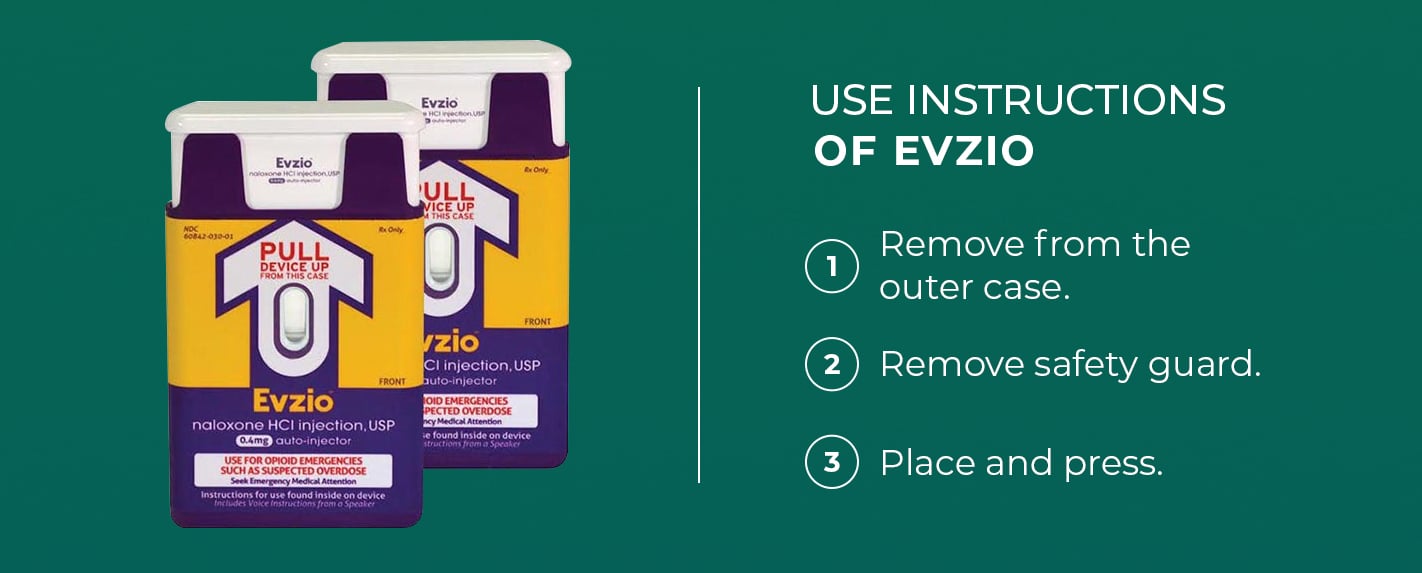
What Is EVZIO?
EVZIO, like NARCAN, delivers naloxone to individuals who are overdosing. However, it uses an auto-injector to introduce the medication directly into the bloodstream. It provides auditory instructions to guide you through the process, which can help calm the extreme nerves that often occur in the high-pressure situation of responding to an overdose. The instructions for EVZIO are more involved than those for NARCAN.
- Remove from the outer case: Pull the EVZIO unit out. Do NOT proceed to step two until you are ready to use the auto-injector immediately. If you are not prepared, put EVZIO back in the outer case.
- Remove safety guard: Pull off the red safety guard, while avoiding the black base of the auto-injector. The red safety guard is designed to fit very tightly. Pull firmly to remove it, and do not replace the guard after you have removed it.
- Place and press: Place the black base of the auto-injector against the overdosing individual’s outer thigh. EVZIO can pierce clothing if necessary. Press firmly and listen for the click and hiss that indicates EVZIO is working. Hold for five seconds.
It’s imperative to keep the injector firmly pressed to the thigh for a full five seconds after hearing the click and hiss. At that point, the needle will retract into the unit and will no longer be visible.
EVZIO’s high-tech delivery system of injectable naloxone comes with a less affordable price tag. Medicare generally does not cover this drug, and paying out of pocket for it can cost upwards of $4,000. However, many commercial insurance plans cover EVZIO. The manufacturer has also developed a program in which patients whose insurance does not cover EVZIO can receive it for no cost out of pocket.
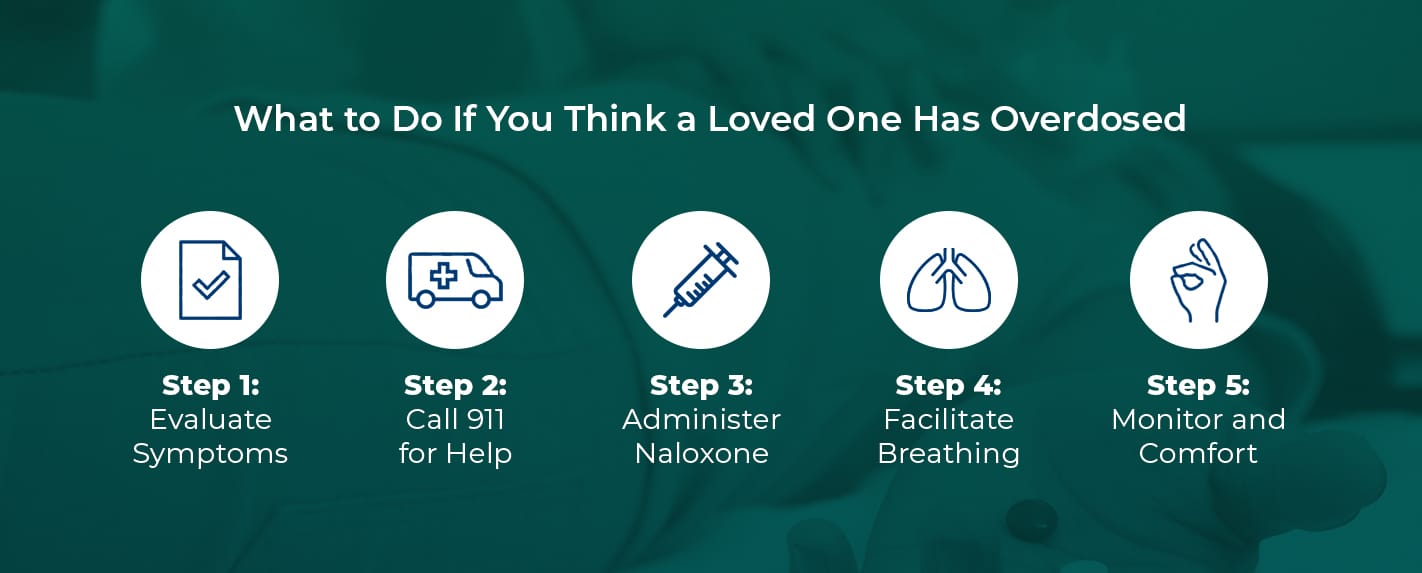
What to Do If You Think a Loved One Has Overdosed
Opioid overdose is the worst-case scenario for both the person suffering the overdose and the people nearby as it happens. Overdoses can be fatal, as one of the most prominent symptoms is depression of the respiratory system that prevents the sufferer from breathing. As someone equipped with naloxone, your quick thinking and levelheadedness can lead to the overdosing individual receiving the help they need in time to survive and make a full recovery.
Step 1: Evaluate Symptoms
The first thing to do is take stock of the person’s symptoms to be sure they are experiencing a genuine opioid overdose and not some other medical event that requires different treatment. Naloxone does not have any effect on non-opioid overdoses like those that can occur with cocaine, alcohol or benzodiazepines. Overdose symptoms to look for include:
- Pallid or clammy face
- Limp body
- Purple or blue fingernails and lips
- Vomiting or gurgling noises
- Slowed or stopped breathing or heartbeat
- Inability to be roused or awakened
- Inability to speak
After identifying any of these symptoms and suspecting an overdose, try to stimulate the individual by calling their name. If that does not elicit a response, try:
- Grinding your knuckles into the breastbone in the middle of the chest
- Rubbing your knuckles on the person’s upper lip
If the person responds, determine whether they can maintain consciousness and responsiveness. If their breathing and alertness remain consistent, continue to monitor the person and keep them awake. If the person does not respond or cannot maintain awareness and breathing on their own, call 911 immediately and then administer a single naloxone dose.
Step 2: Call 911 for Help
Calling 911 can feel like an overwhelming task, but it is essential to get medical experts on the scene when you suspect an overdose. All you need to do is communicate is that someone is unresponsive and not breathing, and give the specific address of your location. You can provide details if the dispatcher requests them. Be sure to follow any instructions the dispatcher provides. Also be sure you’ve shared with them that you are administering a dose of Naloxone.
Step 3: Administer Naloxone
Once you have established that emergency medical services are on the way, it’s time to administer the naloxone. Follow the instructions on the medication packaging to give it to the individual in crisis. Whether you are giving the naloxone nasally or using the auto-injector, the process should take only a couple of minutes at maximum. Sometimes, someone overdosing will not respond to a single dose of naloxone. If they were taking a long-acting opioid or an extremely potent one, you may need multiple doses.
Wait two to three minutes after administering the first dose to see whether it is working. If not, give a second dose. In some cases, like with fentanyl-involved overdoses, the affected individual may even need an intravenous dose or infusion of naloxone administered by a medical professional.
After administering the naloxone, do your best to place the person in the recovery position. Follow these steps for a person lying on their back:
- Take the arm nearest to you and place it at a right angle to their body. The palm should face upward.
- Cross their other arm across their chest, so the back of their hand rests against their cheek. Hold it there.
- Lift their far knee until their foot is flat on the ground, then pull it toward you to roll them onto their side.
The recovery position allows any blood or vomit to drain out, rather than blocking airways and obstructing breathing.
Step 4: Facilitate Breathing
Making sure an overdosing person can breathe is crucial, and it can be a lifesaving intervention on its own. The Substance Abuse and Mental Health Services Administration (SAMHSA) recommends these steps for performing rescue breathing:
- Ensure the person’s airway is clear by checking for objects or substances within their mouth or throat. Your smartphone’s flashlight can help with this.
- Hold the person’s chin, tilt their head back and pinch their nose closed.
- Place your mouth over theirs, make a seal and perform two slow breaths.
- Watch for the person’s chest to rise.
- Give one breath every five seconds.
Chest compressions may be necessary to stimulate breathing. Doing so involves removing the person from the recovery position and placing them on their back. Press hard and fast on the center of the chest while keeping your arms extended. If the person still is not breathing, alternate rescue breathing with chest compressions until help arrives.
Step 5: Monitor and Comfort
People usually start spontaneously breathing again after two to three minutes have passed since the administration of naloxone. Afterward, SAMHSA recommends monitoring the individual for at least four hours after receiving the last dose of naloxone. If the person overdosed on a long-acting opioid, they need even further care.
There are two situations in which you can help the overdosing individual with your continued presence. The emergency medical team may determine the person does not need to go to the hospital and leave them in your care. Alternately, if the person does need to go to the hospital, you may choose to accompany them. Either way, they will likely awaken disoriented and in great discomfort.
Your presence and support may help calm the individual and keep them from going into panic mode. You can also fill them in on the details of what occurred to communicate the gravity of the situation.
What Not to Do When Responding to an Overdose
Following the steps above is the best way to respond when you believe someone is experiencing an opioid overdose. However, you may be tempted to try some inadvisable techniques if it seems like the naloxone isn’t working quickly enough. The following are SAMHSA’s list of things not to do during overdose response.
- Don’t slap the person or otherwise try to stimulate them forcefully. If rubbing your knuckles on their sternum or upper lip does not work, the individual is likely unconscious.
- Don’t put the person into a cold bath or shower. They may fall or go into shock.
- Don’t inject the person with any substance whatsoever besides naloxone.
- Don’t try to make them vomit swallowed drugs. It may cause fatal choking or inhalation of vomit.
Side Effects of Using Naloxone
Because naloxone works by kicking opioids off receptors, replacing them and preventing them from interacting with the central nervous system, taking naloxone will rapidly transition a person into opioid withdrawal. The side effects of EVZIO and NARCAN are the same as those a person would experience if they decided to quit opioids cold turkey without medical assistance. The most common symptoms are:
- Flushing
- Dizziness and weakness
- Tiredness
- Nervousness and restlessness
- Irritability
- Muscle aches and cramps
- Abdominal cramps
- Stomach pain
- Vomiting
- Diarrhea
- Chills
- Fever
- Goosebumps
- Runny nose
These classic symptoms of opioid withdrawal are uncomfortable, but not usually life-threatening. Naloxone may cause these other, more severe side effects:
- Pain, burning or redness at the injection site (for EVZIO)
- Hives
- Facial swelling
- Hallucinations
- Seizures
If any of these occur, the person may be having an allergic reaction to naloxone and should receive emergency medical treatment as soon as possible.
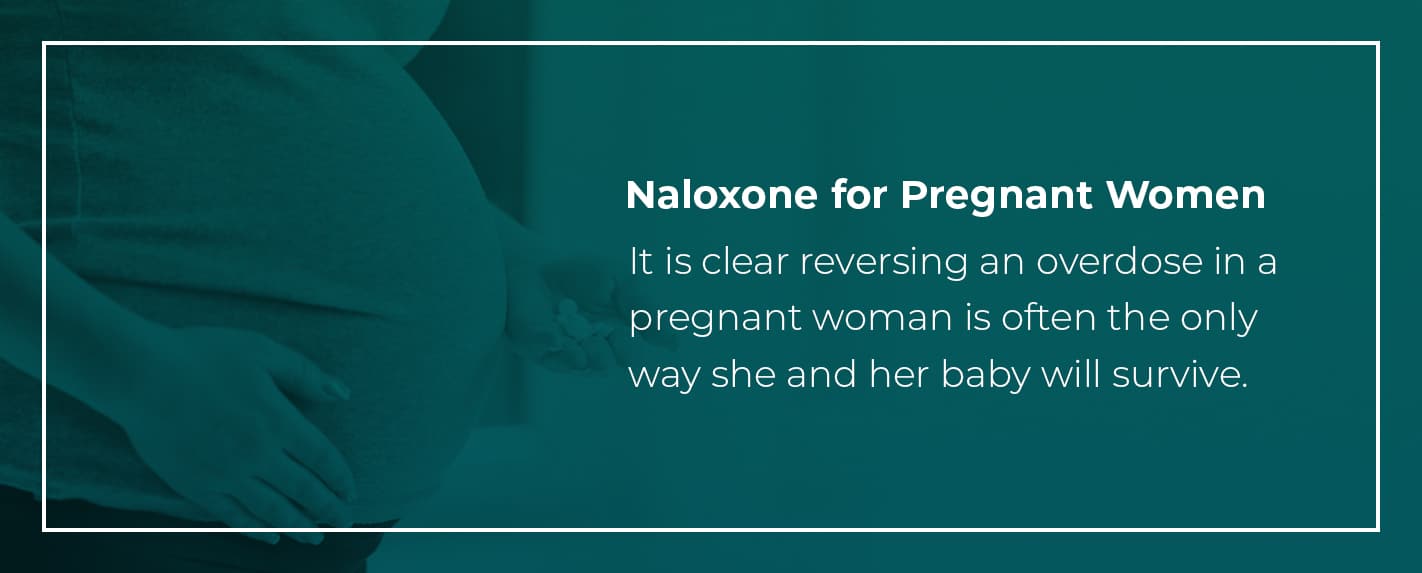
Naloxone for Pregnant Women
Currently, no scientific studies have produced conclusions about whether naloxone has adverse side effects or increases risks for pregnant women and their babies. Given what we know about overdose and the lack of evidence for naloxone being dangerous for pregnant women, it is clear reversing an overdose in a pregnant woman is often the only way she and her baby will survive.
It is possible for the baby to experience opioid withdrawal symptoms while in utero, as well as shortly after birth. However, these symptoms are preferable to the damage caused by lack of oxygen during an overdose.
FAQs About Naloxone You Should Know
Still have questions about this revolutionary medication? Here are some of the most frequently asked questions about naloxone.
Q: What if I give someone naloxone and it turns out they weren’t overdosing on opioids? Will it hurt them?
A: No. Naloxone only affects people with opioids in their system.
Q: Is it possible to overdose on naloxone?
A: No. Naloxone is safe even at high levels.
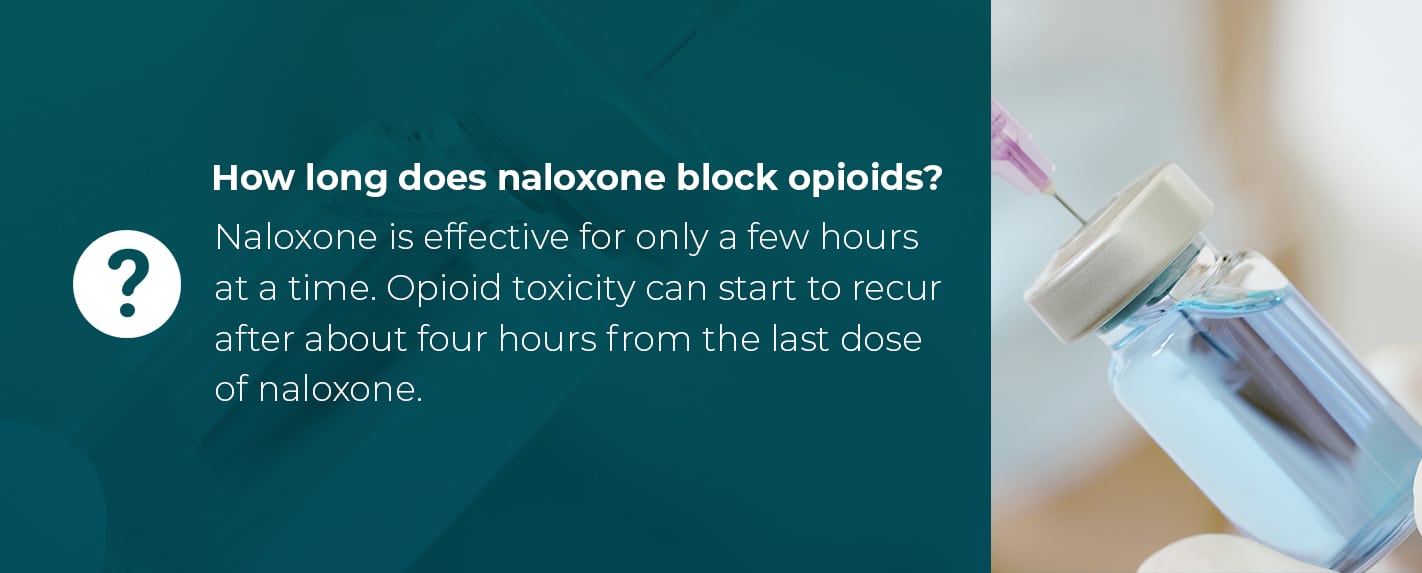
Q: How long does naloxone block opioids?
A: Naloxone is effective for only a few hours at a time. Opioid toxicity can start to recur after about four hours from the last dose of naloxone, so longer-acting opioids like extended-release oxycodone medications may outlive the effects of the medication. Medical intervention is necessary to determine if more naloxone or other medical support should be provided.
Q: What drugs can naloxone reverse the effects of?
A: These are the most common opioids for people to overdose on:
- Fentanyl
- Heroin
- Codeine
- Hydrocodone (Vicodin®)
- Morphine
- Hydromorphone (Dialudid®)
- Oxycodone (OxyContin®, Percocet®)
Q: What’s the difference between naloxone and naltrexone?
A: The two medications are almost identical chemically, but used for different purposes. Naltrexone blocks cravings for opioids and alcohol, but cannot reverse an overdose.
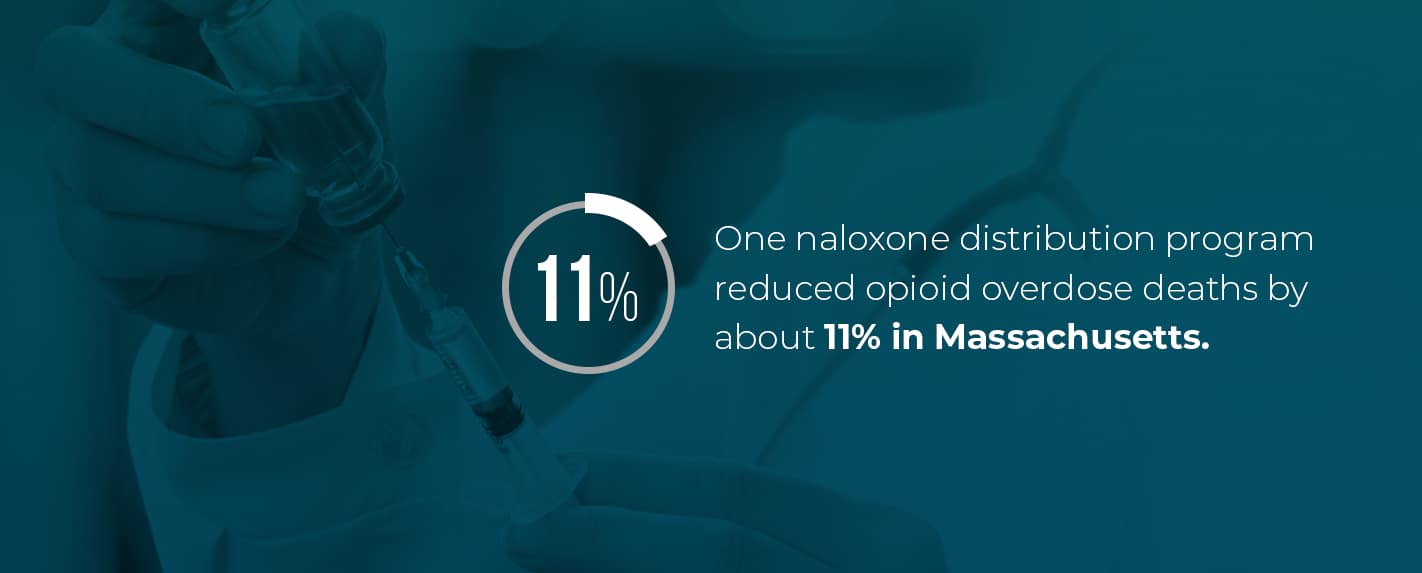
Q: Does naloxone really save lives?
A: Absolutely. One naloxone distribution program reduced opioid overdose deaths by about 11% in Massachusetts, and laypeople reversed at least 26,500 overdoses from 1996 to 2014.
Be Prepared With MedMark
If you know someone who uses opioids — whether in prescription or illicit form — you have likely considered the possibility they might overdose. Preparing yourself for this outcome is emotionally challenging and can be frightening, but obtaining an opioid overdose drug and learning how to use it is perhaps the most concrete step you can take toward preventing a tragic outcome.
While you can pick up a NARCAN or EVZIO kit from a pharmacy on your own, it’s best to consult a physician. Not only will this save you money by involving your insurance, but it will also allow you to ask a qualified professional any questions you have about naloxone or opioid addiction.
Doctors at MedMark Treatment Centers can write prescriptions for naloxone and are experts in the field of addiction. If you have more questions about NARCAN and EVZIO, or are ready to arm yourself with the means to reverse an opioid overdose, contact MedMark online or at 866-840-6658 today.

